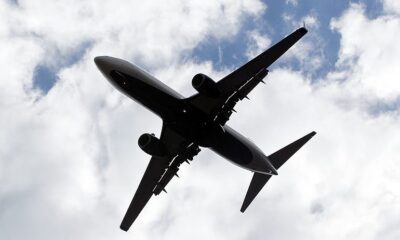Travel
Flight etiquette: TikTok argues over correct way to exit a plane
By Rebecca Ann Hughes
Here’s how social media users think you should exit a plane.
A series of TikTok videos have sparked the latest debate over flight etiquette: how should you leave the plane?
As flying becomes an ever-more exasperating experience thanks to airport disruptions and travel strikes, onboard behaviour is coming under scrutiny.
Controversies have raged over whether seat reclining is permissible, if refusing to switch seats is rude and who should get control of the armrests.
Now, TikTok is thrashing out the topic of disembarking from the aircraft. Here’s how social media users think you should exit the plane.
TikTok debate rages over correct way to exit a plane
The disembarking etiquette debate was sparked by a video posted by TikTokker Quincy Philbin earlier this month.
In the clip, she demonstrates how her boyfriend helps her navigate the rush to leave the aircraft.
She shows how he stands in the aisle behind her, effectively blocking those in the rows after his from passing so that she can leave easily in front of him.
In the on-screen caption, she describes the gesture as “very simple but very sweet.”
The video quickly racked up over two million views and hundreds of comments. Many users applauded the man for his actions.
Others considered it unremarkable, “the most normal thing ever” and something that “everyone does” for the other people they are with.
On the other hand, some commenters saw it as disrespectful and rude to passengers behind in a rush to leave the plane.
“Not me thinking it’s actually a rubbish thing to do for all the other people waiting to leave the plane too,” one viewer wrote, sparking a series of responses.
Should passengers leave the plane row by row?
The video caused many viewers to comment that the correct way to exit a plane is row by row.
“The people behind her should be waiting regardless of if he stops them or not. Plane should deboard front to back,” wrote one viewer.
“For people who actually have decorum and class, you usually wait for the seats in front of [you] to get out rather than pushing past them. Unless they’re sat [down],” said another.
Earlier in June, another TikTok user posted a video calling out those that crowd the aisle attempting to get off first.
“Since when did aeroplane etiquette of getting off the plane row by row end!?!?!” the on-screen caption reads.
Commenters described it as their “biggest pet peeve” and something that drives them crazy. Others agreed but made the exception for those who have a tight flight connection.
Some airlines may have started to enforce row-by-row deboarding. “Last time I flew JetBlue they actually put a little message on everyone’s screen reminding us to do just that!” said one commenter.
Travel
Venice’s daytripper fee returns this week, rising to €10 for last-minute bookings
Venice’s daytripper tax is relaunching this week, and the fee has doubled to €10 for last-minute visitors.
Mayor Luigi Brugnaro stressed that the tax aims to help the city and its citizens battle overtourism and avoid huge influxes of visitors during crowded holidays and weekends.
The payment system was launched last year for a time-limited pilot program.
Venice introduced the long-discussed daytripper fee after the city narrowly escaped being placed on the UN’s list of endangered heritage sites, due largely to the impact of overtourism.
Visitors staying overnight in the historic centre are exempt from the charge as they already pay a tourist tax.
How does Venice’s entry fee work?
The new tax will be applied every Friday through Sunday and on holidays from 18 April to 27 July, for a total of 54 days.
That’s almost double the number of days it was in place last year. Tourists who don’t make reservations up to four days in advance will pay €10 instead of the usual €5.
The tax will be in force during peak hours, from 8.30 am to 4 pm.
Anyone found beyond designated control points without the required documentation will be subject to fines.
These will range from €50 to €300, plus the maximum entrance fee allowed by law, set at €10.
Officials have emphasised that the programme aims to reduce crowds on peak days, encourage longer visits and improve the quality of life for residents.
The fee is not required for anyone staying in Venice, including the mainland districts of Marghera and Mestre. Venice’s islands, including glass-making Murano, are also outside the program.
Exemptions are also issued for a variety of reasons, including to access the city for work, school or medical care, as well as to people born in Venice and residents of the Veneto region.
How can I book my ticket for Venice?
Visitors can ‘reserve’ their day in Venice on a dedicated platform.
Daytrippers pay the required fee (€5 or €10) and get a QR code that will then be checked at spot controls at seven access points around the city, including at the main train station.
Visitors with hotel reservations enter their hotel information and also get a QR code to show. They don’t have to pay, however, since their hotel bill will already include a Venice lodging fee.
Why has Venice introduced an entry fee?
Venice has long suffered under the pressure of overtourism, but officials say pre-pandemic estimates ranging from 25 to 30 million visitors a year – including daytrippers – are not reliable and that the pilot project also aimed to come up with more exact figures to help better manage the phenomenon.
By contrast, registered visitors spending the night last year numbered 4.6 million, according to city figures, down 16 per cent from pre-pandemic highs.
The pandemic delayed Venice’s plans to launch the daytripper tax, which has become a keystone of the city’s attempts to deal with overtourism.
UNESCO cited the plan when it decided not to include the city on the list of endangered world heritage sites last September, a tarnish that it similarly avoided two years earlier with the cruise ship ban through St. Mark’s Basin and the Giudecca Canal.
Cruise ships brought 1.6 million people to Venice in 2019.
Activists sounded a warning last summer when the number of tourist beds officially overtook the number of residents, which has dwindled to under 50,000 in a trend dating back decades.
They said the imbalance drains the city of services, clogging its tight alleyways and water buses with suitcase-toting tourists and pushing residents to the mainland with its conveniences.
Was the trial of the entry fee a success?
At the end of the first test phase last July, officials said the tax had netted €2.4 million, accounting for about 1,000 entrances on each of the test days.
Brugnaro responded to critics who have called it a failure and said it did not deter as many arrivals as expected.
“Venice is the first city in the world that tries to manage the problem of overtourism. We obtained important results,” the mayor said.
But some citizens’ groups and opposition councillors claim the access fee completely failed to control overtourism.
“Data offered by the control room show that on average during the period of implementation of the fee, we had about 7,000 more tourist entries than in previous years,” said Giovanni Andrea Martini, an opposition councillor.
“This shows that the access fee is not at all a system able to manage the flows.”
Travel
Give back while you travel: Fiji’s ‘Loloma Hour’ invites visitors to help protect paradise
Forget your average happy hour. Fiji wants travellers to trade sundowners for something more meaningful.
The Pacific Island nation’s ‘Loloma Hour’ invites visitors to spend at least one hour of their trip giving back to the environment or local communities.
Whether it’s replanting mangroves, taking part in a beach clean-up or learning to make traditional crafts alongside Fijian villagers, the goal is simple: leave the islands better than you found them.
“True happiness comes not just from what you take, but what you give,” says Srishti Narayan, chief marketing officer at Tourism Fiji.
What is Loloma Hour?
‘Loloma’ is a Fijian word meaning generosity driven by love, and the new programme reflects that spirit.
Rolled out across dozens of eco-minded hotels, resorts and tour operators, Loloma Hour is part of Fiji’s wider strategy to preserve its cultural heritage and natural ecosystems while creating meaningful exchanges between travellers and locals.
The initiative supports activities that align with four key pillars: wildlife conservation, community support, reef protection and coastline care. Guests might join a coral planting session, participate in iguana conservation walks, take part in reef-safe snorkelling or attend a village storytelling event.
The aim is for tourists to contribute at least 5,000 volunteer hours across the country this year.
Tourism with purpose is on the rise
Fiji’s bet on mindful travel taps into a growing trend.
According to a 2023 Booking.com survey, 76 per cent of global travellers say they want to travel more sustainably.
In Europe, the demand is especially high, and operators are answering the call. Five of the 10 most sustainable destinations in 2024 were in Europe, according toLonely Planet, and destinations like the Faroe Islands and Normandyhave been praised for pioneering community-based and regenerative tourism programmes.
From Thailand toGreenland, tourism boards and private operators alike have started rethinking everything frominteractions with wildlife todiving excursions to make them more purposeful.
Among them, Fiji’s Loloma Hour stands out for its cultural framing – rooted in love rather than obligation.
But it also has a deeper meaning. The Pacific Islands are on the frontlines of the climate crisis, pressed with rising sea levels, coral bleaching and extreme weather events. With tourism making up about 40 per cent of Fiji’s GDP, turning tourism into a tool for change isn’t just good policy. It might also be essential for the country’s future.
Where guests can get involved
From five-star hideaways to barefoot eco-resorts, 21 properties across Fiji are currently taking part in Loloma Hour – each offering different activities.
At Six Senses Fiji, guests can swim through coral nurseries with experts, plant native trees or tour the resort’s organic gardens. The Jean-Michel Cousteau Resort offers marine education sessions led by in-house biologists.
On islands like Malolo and Wakaya, guests can document vulnerable manta ray populations while diving or join mangrove replanting sessions and beach clean-ups.
“Loloma Hour gives visitors a chance to help preserve what makes Fiji so special – its people, environment and traditions,” says Narayan.
Travel
Facial recognition and phone-based boarding passes: Why the future of flying could be paperless
If a ground-breaking proposal comes to pass, you may soon be saying bon voyage to boarding passes.
In one of the most significant shake-ups to air travel in decades, the International Civil Aviation Organisation (ICAO) has announced plans to eliminate paper boarding passes and check-in as we know it.
Instead, passengers could use a digital travel credential – stored on their smartphones – to move through airports using facial recognition.
A digital ID to pilot the future of travel
Developed by the ICAO, the UN agency that sets global aviation standards, the digital credential would be used alongside facial recognition to replace physical documents throughout the airport, from bag drop to the boarding gate.
Travellers would download a “journey pass” that updates automatically if any changes occur, such as a flight delay or cancellation.
Trials of these novel solutions are already taking off.
Countries such as Finland have already launched a DTC pilot programme, while airports have experimented with the use of this emerging technology. Singapore’s Changi has expanded its biometric lanes, and in 2019, Amsterdam’s Schiphol introduced facial recognition technology for boarding on select flights.
Airlines have also begun to embrace digitalisation. As soon as November this year, Ryanair has announced plans to scrap paper boarding passes.
Why now?
The plan comes as airlines and airports seek to streamline operations and reduce costs, especially as global travel continues its post-pandemic rebound.
According to the International Air Transport Association (IATA), the number of air passengers is expected to double to eight billion by 2040. That surge will place pressure on airports to process passengers more efficiently. Digital IDs are seen as a key solution to that growing challenge.
But there’s another motivator: security. The ICAO says the new system could help crack down on identity fraud and human trafficking by providing a more robust way to verify who’s flying.
By relying on biometric data, which is unique to each person, the system promises greater accuracy than paper-based documentation can provide on its own.
Privacy, please
Valérie Viale, director of product management for travel technology company Amadeus, told The Times that these changes could be the most consequential since the adoption of e-ticketing in the early 2000s.
“The industry has now decided it’s time to upgrade to modern systems that are more like what Amazon would use,” she said.
If the plans develop as the ICAO envisions, boarding passes are only the beginning. Even passports could become a thing of the past in the future.
Despite digitalisation being a boon to traveller convenience, not everyone is on board. Critics have voiced concerns about privacy, surveillance and data breaches. Others have decried the lack of transparency around the technologies being deployed.
For its part, Amadeus has sought to reassure travellers. The company has said that its newly developed system will wipe passenger data within 15 seconds of contact with any “touchpoint,” such as baggage drop or pre-security checks.
And the ICAO insists that developing a digital travel credential remains optional for every nation.
That means you can keep your passport and boarding passes on hand for now. But don’t be surprised if your smartphone or face soon becomes your ticket to fly.
-

 EU & the World3 days ago
EU & the World3 days agoHow Old Are the Menendez Brothers in 2025? Lyle and Erik’s Ages Today
-

 EU & the World4 days ago
EU & the World4 days agoWhere to Stream Coachella 2025: How to Watch the Show
-

 EU & the World3 days ago
EU & the World3 days agoCelebrities Going to Space: Katy Perry & More in the Blue Origin Crew
-

 EU & the World5 days ago
EU & the World5 days agoPlane Crash in Boca Raton: What Happened & Updates on the Accident
-

 Sports3 days ago
Sports3 days agoDavid Massey: “A historic edition for the Rolex Monte Carlo Masters.”
-

 EU & the World3 days ago
EU & the World3 days agoHow Did Kyren Lacy Die? Updates on the LSU Player’s Death
-

 EU & the World6 days ago
EU & the World6 days agoWhere to Watch the Masters: Can I Stream the Live Coverage?
-

 EU & the World6 days ago
EU & the World6 days agoJillian ‘Lauren’ Shriner: 5 Things About the Weezer Bassist’s Wife









